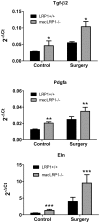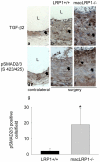Macrophage LRP1 suppresses neo-intima formation during vascular remodeling by modulating the TGF-β signaling pathway
- PMID: 22174911
- PMCID: PMC3235159
- DOI: 10.1371/journal.pone.0028846
Macrophage LRP1 suppresses neo-intima formation during vascular remodeling by modulating the TGF-β signaling pathway
Abstract
Background: Vascular remodeling in response to alterations in blood flow has been shown to modulate the formation of neo-intima. This process results from a proliferative response of vascular smooth muscle cells and is influenced by macrophages, which potentiate the development of the intima. The LDL receptor-related protein 1 (LRP1) is a large endocytic and signaling receptor that recognizes a number of ligands including apoE-containing lipoproteins, proteases and protease-inhibitor complexes. Macrophage LRP1 is known to influence the development of atherosclerosis, but its role in vascular remodeling has not been investigated.
Methodology/principal findings: To define the contribution of macrophage LRP1 to vascular remodeling, we generated macrophage specific LRP1-deficient mice (macLRP1-/-) on an LDL receptor (LDLr) knock-out background. Using a carotid ligation model, we detected a 2-fold increase in neointimal thickening and a 2-fold increase in the intima/media ratio in macLRP1-/- mice. Quantitative RT-PCR arrays of the remodeled vessel wall identified increases in mRNA levels of the TGF-β2 gene as well as the Pdgfa gene in macLRP1-/- mice which could account for the alterations in vascular remodeling. Immunohistochemistry analysis revealed increased activation of the TGF-β signaling pathway in macLRP1-/- mice. Further, we observed that LRP1 binds TGF-β2 and macrophages lacking LRP1 accumulate twice as much TGF-β2 in conditioned media. Finally, TNF-α modulation of the TGF-β2 gene in macrophages is attenuated when LRP1 is expressed. Together, the data reveal that LRP1 modulates both the expression and protein levels of TGF-β2 in macrophages.
Conclusions/significance: Our data demonstrate that macrophage LRP1 protects the vasculature by limiting remodeling events associated with flow. This appears to occur by the ability of macrophage LRP1 to reduce TGF-β2 protein levels and to attenuate expression of the TGF-β2 gene resulting in suppression of the TGF-β signaling pathway.
Conflict of interest statement
Figures










References
-
- Strickland DK, Ashcom JD, Williams S, Burgess WH, Migliorini M, et al. Sequence identity between the a2-macroglobulin receptor and low density lipoprotein receptor-related protein suggests that this molecule is a multifunctional receptor. J Biol Chem. 1990;265:17401–17404. - PubMed
-
- Moestrup SK, Gliemann J. Purification of the Rat Hepatic a2-Macroglobulin Receptor as an Approximately 440 kDa Single Chain Polypeptide. J Biol Chem. 1989;264:15574–15577. - PubMed
Publication types
MeSH terms
Substances
Grants and funding
LinkOut - more resources
Full Text Sources
Molecular Biology Databases
Research Materials
Miscellaneous

